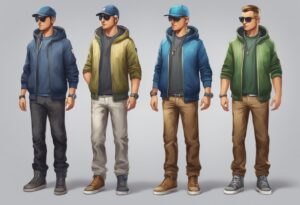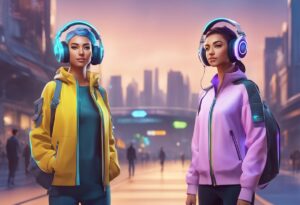The concept of the metaverse has become increasingly popular in recent years, and with it, the demand for digital fashion has grown. Digital fashion allows individuals to express themselves in a unique and creative way, without being limited by physical garments. With the rise of virtual and augmented reality technologies, it has become easier than ever to create and wear digital clothing in the metaverse. In this blog post, I will provide you a step by step guide on how to make metaverse clothing and tips to make the process easier.
Creating digital clothing for the metaverse is a process that involves a combination of technology and creativity. It is important to have a clear understanding of the metaverse and the platforms where the digital clothing will be worn. The Fabricant Studio is an example of a platform that allows users to create, mint, and trade digital garments as NFTs. Tools like Len Studio can also be used to bring clothing to life in a digital form, using cloth physics, refraction math, full-body tracking, and collision data.
In order to create successful digital clothing, it is important to keep in mind the unique features of the metaverse. Digital clothing should be designed with movement and interaction in mind, as avatars will be able to move and interact with the environment. Additionally, digital clothing should be optimized for the platforms where they will be worn, to ensure that they are visually appealing and functional. By combining creativity and technology, individuals can create unique and expressive digital clothing for the metaverse.
Understanding the Metaverse and Digital Fashion
The metaverse is a virtual world that is becoming increasingly popular and is expected to be the next big thing in technology. In the metaverse, users can create and customize their avatars, interact with other users, and participate in a variety of activities. One of the most exciting aspects of the metaverse is the ability to wear digital clothing or virtual garments.
Digital clothing is a new form of fashion that is gaining popularity in the metaverse. It allows users to express their creativity and individuality by wearing unique and personalized outfits. Digital clothing is also environmentally friendly as it eliminates the need for physical production and waste.
Digital Identity and Self-Expression
In the metaverse, users can create a digital identity that reflects their personality and interests. Digital clothing plays an important role in this as it allows users to express themselves in new and exciting ways. Users can mix and match virtual garments to create unique outfits that represent their individual style.
Digital fashion also allows users to experiment with different styles and trends without the financial commitment of physical clothing. Users can try on different outfits and see how they look before deciding to purchase them.
The Role of Augmented Reality and Virtual Reality
Augmented reality (AR) and virtual reality (VR) technologies play a crucial role in the metaverse and digital fashion. AR and VR technologies allow users to experience the metaverse and virtual garments in a more immersive way. Users can see themselves wearing digital clothing in real-time using AR technology, which enhances the overall experience.
VR technology allows users to fully immerse themselves in the metaverse and interact with other users in a virtual environment. Users can also see their avatars wearing digital clothing in a more realistic way using VR technology.
The metaverse and digital fashion are rapidly evolving technologies that offer many exciting opportunities for users. Digital clothing plays an important role in the metaverse by allowing users to express themselves and experiment with different styles. AR and VR technologies enhance the overall experience by providing a more immersive and realistic environment.
Creating Metaverse Clothing: A Step-by-Step Guide

Creating clothing for the metaverse involves designing and rendering digital garments that can be worn by avatars within virtual environments. Here’s a step-by-step guide to making metaverse clothing:
Step 1: Conceptualize Your Design
Start with a concept for your clothing item. Consider the style, audience, and the virtual environment where it will be worn. Sketch your ideas, keeping in mind that unlike physical clothing, metaverse fashion can defy gravity, traditional materials, and real-world limitations.
Step 2: Learn the Platform’s Requirements
Different metaverse platforms have specific requirements for digital assets. Familiarize yourself with the technical specifications, such as file formats, polycount limits, and texture sizes for the platform you’re designing for.
Step 3: Create a 3D Model
Using 3D modeling software like Blender, Maya, or Marvelous Designer, create your clothing item. Pay attention to details that will make your design stand out. Ensure that your model is optimized for the virtual environment, with the correct topology and level of detail.
Step 4: Texture Your Model
Apply textures and materials to your model to give it color, depth, and realism. You can create these textures from scratch or use photographs to create more realistic materials. Consider using software like Substance Painter for detailed texturing work.
Step 5: Rig and Skin the Model
Rigging is the process of creating a skeleton for your model so that it can move with an avatar. Skinning is attaching the mesh of your model to the rig. This step is crucial for making sure your clothing moves naturally with the avatar’s animations.
Step 6: Test on Avatars
Import your rigged clothing into the metaverse platform and test it on avatars. You’ll want to check for any issues with movement, clipping, or textures and make necessary adjustments.
Step 7: Optimize for Performance
Ensure that your clothing item is optimized for performance to prevent lag in the virtual environment. This might involve reducing the polygon count, compressing textures, or simplifying the rig.
Step 8: Set Up Metadata and Interactions
Define the metadata for your item, such as the name, description, and price. If the platform allows, set up any interactive features or special effects that your clothing will have.
Step 9: Publish to the Platform
Once your item is complete and tested, follow the platform’s process for publishing digital assets. This could involve submitting your item for review or directly uploading it to a marketplace.
Step 10: Promote Your Clothing
Market your clothing item through social media, virtual fashion shows, or collaborations with influencers. Engage with the community to get feedback and create buzz around your designs.
Step 11: Iterate Based on Feedback
After your clothing is available, listen to the feedback from users and make improvements for future designs. This iterative process will help you refine your skills and better understand the needs and wants of the metaverse community.
Remember to stay updated with the latest trends and technologies in the metaverse as they are rapidly evolving. Continuous learning and adaptation are key to success in digital fashion.
Designing for Avatars
Designing clothing for avatars in the metaverse is similar to designing clothing for real-life models. However, there are some key differences to keep in mind.
Avatars come in a range of shapes and sizes, so it is important to ensure that your designs are versatile and can fit a variety of body types. Additionally, avatars have different movement capabilities than real-life models, so it is important to design clothing that can move and stretch with the avatar’s movements.
Tools and Software Essentials
To create high-quality metaverse clothing, designers need access to the right tools and software. One popular software for creating digital clothing is Marvelous Designer. This software allows designers to create realistic 3D clothing designs that can be easily exported to popular metaverse platforms. Additionally, Photoshop can be used to create textures and designs that can be applied to the 3D clothing models.
From Concept to Digital Wearable
The process of creating metaverse clothing starts with a concept. Once a designer has an idea for a piece of clothing, they can use Marvelous Designer to create a 3D model of the garment. From there, they can apply textures and designs using Photoshop. Once the design is complete, it can be exported to the metaverse platform of choice.
Creating metaverse clothing requires a combination of design skills and technical knowledge. By using the right tools and software, designers can create high-quality digital clothing that can be worn by avatars in the metaverse. The Fabricant Studio is one example of a company that specializes in creating digital fashion for the metaverse.
The Business of Fashion in the Metaverse

As the metaverse continues to grow, fashion brands are beginning to explore the potential of this new digital environment. From collaborations to NFTs, there are numerous opportunities for fashion brands to engage with consumers in the metaverse.
Collaborations and Brand Partnerships
One way fashion brands are entering the metaverse is through collaborations and brand partnerships. Gucci, Louis Vuitton, Nike, and Ralph Lauren are just a few examples of brands that have already entered the metaverse through collaborations with gaming companies.
These collaborations allow fashion brands to reach a new audience and engage with consumers in a new way. For example, in 2020, Gucci partnered with the virtual fashion platform Genies to create digital clothing items that users could purchase and wear on their Genies avatars.
Monetizing Digital Fashion through NFTs
Another way fashion brands are entering the metaverse is through NFTs. NFTs, or non-fungible tokens, are unique digital assets that can be bought and sold on the blockchain. In the metaverse, NFTs can be used to represent digital fashion items.
Several fashion brands have already begun to explore the potential of NFTs in the metaverse. In 2021, luxury fashion brand Gucci released a collection of NFTs called Gucci Aria. The collection featured unique digital items, such as a virtual bag and a pair of virtual sneakers.
By monetizing digital fashion through NFTs, fashion brands can create a new revenue stream and offer consumers a new way to engage with their brand.
Integrating Metaverse Clothing with Gaming and Social Media
Fashion in Virtual Gaming Worlds
Metaverse clothing has become a popular trend in virtual gaming worlds such as Roblox, Decentraland, and The Sandbox. Players are now able to create and customize their avatars with unique digital clothing items. This has created a new market for fashion designers to showcase their designs and collaborate with gaming companies to create unique clothing items for players.
Designers can leverage gaming communities to gain recognition for their work and increase their brand awareness. They can also participate in virtual fashion events to showcase their designs and collaborate with influencers and fashion brands to expand their reach.
Leveraging Social Media for Digital Fashion
Social media is another platform where designers can showcase their metaverse clothing designs. They can create social media feeds to display their work and interact with their followers. Social media platforms like Instagram, TikTok, and Twitter have become popular channels for fashion designers to share their digital fashion designs.
Designers can also participate in virtual fashion shows on social media to showcase their metaverse clothing designs. Social media has become a powerful tool for designers to gain recognition for their work and connect with their audience.
Metaverse clothing has become a popular trend in virtual gaming worlds and social media platforms. Designers can leverage these platforms to showcase their designs and collaborate with influencers and fashion brands to expand their reach. The future of metaverse clothing looks bright, and it will be exciting to see how it evolves in the coming years.

Sustainability and Future Trends in Virtual Fashion
Eco-Friendly Aspects of Digital Clothing
As the fashion industry continues to face scrutiny for its environmental impact, digital clothing and the metaverse offer a potential solution. Digital clothing allows for the creation of virtual garments that can be worn and displayed without the need for physical production. This eliminates the need for materials and resources used in traditional clothing production, making digital clothing a more sustainable option.
Furthermore, digital clothing can be designed to be infinitely customizable and reusable, reducing the need for constant production of new garments.
This not only saves resources but also reduces the amount of textile waste produced by the fashion industry.
Predicting the Evolution of Fashion Technology
As technology continues to advance, the metaverse and digital fashion are expected to converge with the internet of things, creating a seamless integration between the physical and virtual worlds. This convergence could lead to the creation of garments that can change color and texture based on the wearer’s environment or mood, or even garments that can adapt to different body shapes and sizes.
As the metaverse and digital fashion continue to evolve, it’s important for the industry to prioritize sustainability and eco-friendliness in its practices. By doing so, the fashion industry can help reduce its environmental impact while still offering consumers the ability to express themselves through fashion in new and innovative ways.

Frequently Asked Questions
What steps are involved in designing metaverse clothing?
Designing metaverse clothing involves several steps, starting with concept development, followed by sketching and rendering, 3D modeling, texturing, and finally exporting the design to the metaverse platform. The designer must also consider the technical specifications and limitations of the platform, such as file size and format, and ensure that the garment is compatible with the target audience’s devices.
Can digital fashion be sold for real currency, and if so, how?
Yes, digital fashion can be sold for real currency through non-fungible tokens (NFTs). NFTs are unique digital assets that represent ownership of a particular virtual item. The buyer can then use the NFT to access and use the virtual garment in the metaverse environment. The designer can also choose to sell the NFT on a marketplace platform, such as OpenSea or Nifty Gateway.
What are the costs associated with creating virtual garments?
The costs associated with creating virtual garments can vary depending on the complexity of the design and the tools used. Some designers use free or low-cost software, while others may invest in more advanced software and hardware. Additionally, 3D modeling and texturing can be time-consuming and require specialized skills, which may increase the cost of production.
How do you open a fashion storefront in the metaverse environment?
Opening a fashion storefront in the metaverse environment involves choosing a platform, creating a virtual storefront, and uploading the virtual garments for sale. Some popular metaverse platforms for fashion include Decentraland, Somnium Space, and The Sandbox. The designer must also consider marketing and promotion strategies to attract potential customers.
What tools do designers use to create digital couture?
Designers use a variety of tools to create digital couture, including 3D modeling software such as Blender or Maya, texturing software such as Substance Painter, and game engines such as Unity or Unreal Engine. Some designers may also use specialized tools such as Marvelous Designer for creating realistic fabric simulations.
How is digital clothing integrated and used within the metaverse?
Digital clothing is integrated and used within the metaverse through the use of avatars. Avatars are virtual representations of users within the metaverse environment, and digital clothing can be worn and customized by the avatar. Digital clothing can also be used for virtual events, such as fashion shows or social gatherings, and can be traded or sold among users through NFT marketplaces.




